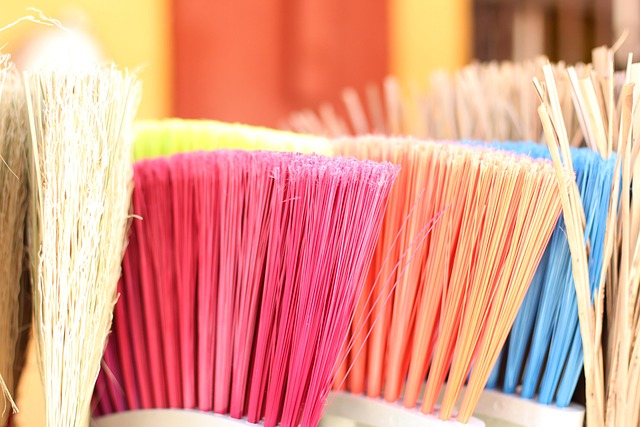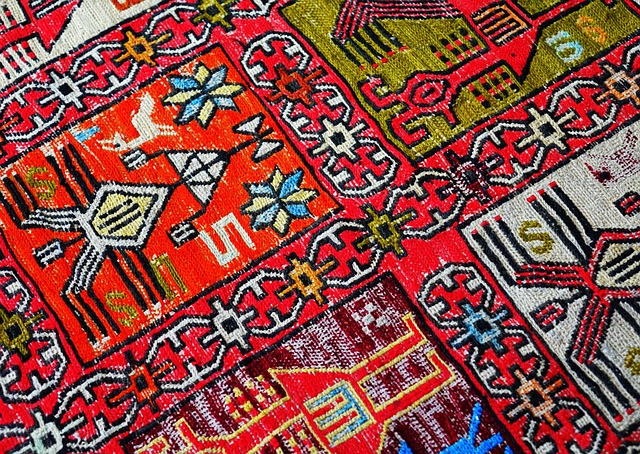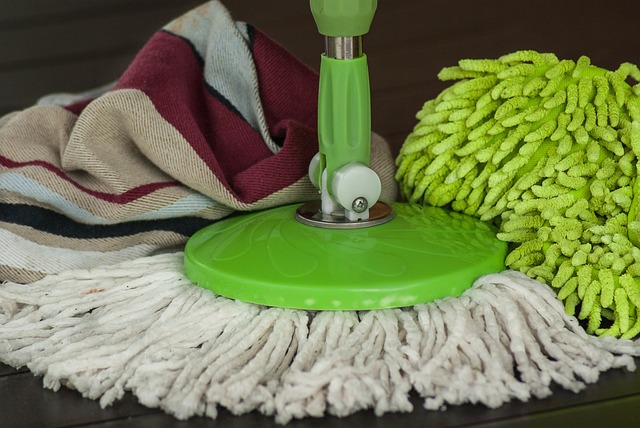Dry carpet cleaning is a popular, efficient method preserving carpet hygiene without excessive water usage. It involves applying specialized absorbent powders or gels to draw out dirt, dust, and stains while breaking down stains. After treatment, powerful vacuums remove the product, leaving carpets clean, soft, and dry for immediate use. Benefits include quick drying times, minimal water usage, and carpet lifespan preservation. Ideal for high-traffic areas, stairs, and rooms with limited ventilation. Proper preparation includes vacuuming and pre-treating stains. Key tools are high-quality solutions and reliable cleaners. Common mistakes involve using incompatible cleaners, improper application, and walking on the carpet before drying. Regular maintenance practices include vacuuming, addressing spills promptly, using natural deodorizers, and rotating furniture. Eco-friendly dry cleaning methods utilize natural enzymes or CO2 to reduce environmental impact while maintaining effective cleaning.
“Uncover the secrets to revitalizing your carpets without the messy flood! This comprehensive guide delves into the world of Dry Carpet Cleaning, offering a modern solution for a fresh and hygienic home. Learn how this method, employing specialized equipment and natural products, provides numerous advantages over traditional wet cleaning. From understanding the basics to mastering the step-by-step process, we’ll navigate you through achieving a spotless and fragrant carpet without the hassle of lengthy drying times. Embrace the convenience and benefits of dry carpet cleaning for a healthier living space.”
Understanding Dry Carpet Cleaning: The Basics

Dry carpet cleaning is a popular and effective method for maintaining the hygiene and freshness of your carpets without the need for extensive water usage. This process involves the use of specialized equipment to gently extract dirt, dust, and debris from the fibers of your carpeting. Unlike traditional wet cleaning, which can leave carpets damp and vulnerable to mold growth, dry cleaning is a quick and efficient solution.
The basic principle behind dry carpet cleaning is to apply a safe, fine powder or gel to the carpet’s surface. This substance acts as an absorbent, drawing out grime and odors as it dries. Once applied, the product is left to work for a set period, allowing it to break down stains and freshen the fibers. Then, using powerful vacuums, the cleaner removes the treated powder, leaving your carpets feeling clean, soft, and dry—ready for immediate use once again.
Benefits of Choosing a Dry Method

Choosing a dry carpet cleaning method offers numerous benefits, making it an attractive option for many homeowners. Unlike traditional wet cleaning, which involves extensive water usage and potential moisture damage, dry cleaning is a gentle yet effective way to refresh your carpets. One of the key advantages is its quick drying time, allowing you to use your carpet immediately after treatment, without the worry of prolonged dampness that can attract dirt and bacteria or lead to mold issues.
This method is particularly suitable for sensitive areas like high-traffic spaces, stairs, and rooms with limited ventilation. It also preserves the lifespan of your carpets by avoiding the potential shrinkage or damage caused by excessive water. Dry cleaning techniques use specialized equipment to extract dirt and stains, leaving your carpets clean, soft, and free from the musty odors that can linger after wet cleaning processes.
How Does Dry Carpet Freshening Work?

Dry carpet freshening is a revolutionary method that transforms your tired-looking carpets into their former glory without the need for traditional wet cleaning. This innovative process involves using specialized dry cleaning solutions and techniques to thoroughly clean and revitalize your carpets. By eliminating the need for large amounts of water, it ensures minimal disruption to your home or business while delivering exceptional results.
The technique starts with the application of a dry carpet cleaner, which is a powdery compound designed to attract and encapsulate dirt, dust, and other debris. This powdery substance works like a magnet, absorbing stains and odors as it spreads across the carpet fibers. Once applied, a special brush or pad is used to gently agitate the cleaner, breaking down embedded grime. As the cleaner and dirt are lifted from the fibers, the result is a clean, fresh-smelling carpet with improved texture and appearance, all without leaving behind any moisture.
Pre-Treatment: Preparing Your Carpet for Cleaning

Before diving into the dry carpet cleaning process, proper preparation is key. Start by vacuuming your carpet thoroughly to remove any loose dirt, dust, or debris. This step is crucial as it ensures that the cleaning solution can effectively reach and penetrate the fibers of your carpet. Regular vacuuming also helps extend the life of your carpet and maintain its overall health.
Additionally, address any existing stains or odors before cleaning. Pre-treat problem areas with a suitable stain remover, allowing it to sit for a few minutes to break down the stains. This pre-treatment step will make the cleaning process more efficient and ensure better results. By preparing your carpet beforehand, you’re setting the stage for a deeper clean using dry cleaning methods.
Choosing the Right Equipment and Products

When it comes to dry carpet freshening, selecting the appropriate equipment and products is a crucial step for achieving optimal results in dry carpet cleaning. The right tools can make all the difference, ensuring your carpets look and smell their best. Opt for high-quality dry cleaning solutions designed specifically for carpets; these products are formulated to effectively remove dirt, stains, and odours without moisture. Invest in a reliable dry carpet cleaner that suits your space and fabric types – from upholstery to area rugs. Look for models with adjustable settings to cater to different fibres and levels of soiling.
Additionally, consider accessories like brush attachments and crevice tools to target hard-to-reach areas. Regular maintenance and deep cleaning are key; scheduling dry carpet cleaning sessions can help preserve your carpets’ quality and extend their lifespan. Choosing the right equipment and products not only ensures a thorough clean but also contributes to a healthier indoor environment by eliminating allergens and pollutants that might be present in dirty carpets.
Step-by-Step Guide to Dry Carpet Freshening

Dry Carpet Freshening: A Step-by-Step Guide
To begin, gather the necessary tools: a vacuum cleaner, baking soda, essential oils (optional), and a clean microfiber cloth. Start by vacuuming your carpet thoroughly to remove any dirt, dust, or debris that might be trapped within the fibers. This step is crucial for deep cleaning and freshening. Once vacuumed, sprinkle a generous amount of baking soda over the carpet. Baking soda acts as a natural deodorizer and absorber, helping to eliminate odors and stains. Let it sit for about 15-20 minutes to allow maximum effectiveness.
After the baking soda has had time to work its magic, use a microfiber cloth slightly dampened with warm water (or a mixture of warm water and a few drops of essential oil for added fragrance) to gently wipe down the carpet. This process will help to lift any remaining baking soda particles while also providing a light cleaning. Rinse the cloth frequently in clean water to avoid transferring dirt back onto the carpet. Finally, allow the carpet to air dry completely before walking on it again. This simple and eco-friendly method can effectively revive your carpets, leaving them smelling fresh and looking vibrant.
Common Mistakes to Avoid During the Process

When freshening your carpet through dry cleaning, there are several common mistakes to steer clear of. One frequent blunder is using the wrong cleaner; not all products are created equal, and an unsuitable chemical can damage or discolor your carpeting. Always opt for a cleaner specifically designed for dry carpet cleaning, considering different fabric types.
Another mistake is over-or under-applying the cleaner. Too much product can leave a residue, while too little might not effectively loosen dirt and debris. Following the manufacturer’s instructions carefully ensures optimal results without causing harm to your flooring. Avoid heavy traffic areas until the carpet has fully dried; walking on it prematurely can spread dirt and reduce the cleaning’s effectiveness.
Tips for Maintaining a Fresh and Clean Carpet

Keeping your carpet fresh and clean between professional dry carpet cleaning sessions involves a few simple yet effective practices. Regular vacuuming is key; use a vacuum with strong suction to remove dirt, dust, and debris that can accumulate in fibers. Target high-traffic areas more frequently, as these spots tend to gather the most grime. Additionally, addressing spills immediately is crucial; blot any liquid messes promptly to prevent staining and reduce moisture, which can lead to mold growth if left untreated.
Using carpet deodorizers or natural fresheners like baking soda or essential oils can help eliminate odors. Sprinkle these across your carpet, let them sit for a bit, then vacuum up the remaining powder. Avoid using harsh chemicals or excessive water, as they can damage the carpet fibers and lead to mold issues, especially in drier climates. Regular rotation of furniture also allows air to circulate freely, reducing the chance of dirt and debris building up in one area.
The Environmental Impact of Dry Carpet Cleaning

Dry carpet cleaning methods, while popular for their convenience, have notable environmental implications that often go overlooked. Traditional dry cleaning techniques rely heavily on chemical solutions and powerful machinery, both of which can leave a significant carbon footprint. The use of synthetic chemicals in these processes contributes to air pollution and potential water contamination when not disposed of properly. Moreover, the energy required to power large-scale dry cleaning equipment adds up, making it an energy-intensive practice.
As consumers become more eco-conscious, there’s a growing demand for sustainable alternatives. Dry carpet cleaning offers a promising solution with its reduced use of chemicals and lower energy consumption compared to traditional methods. By adopting greener practices, such as using natural enzymes or carbon dioxide (CO2) based cleaning agents, the industry can minimise its environmental impact while still providing effective cleaning services.
